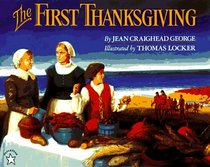Helpful Score: 4
This was a disappointment to me as I was expecting a tale of thanksgiving from a Christian background. For those without this background this might be fine. The first page of the book starts out describing the evolution of earth, rock formations which leads to the formation of plymouth rock 1,000,000 million years ago. Something I didn't think necessary to include. I did not read any further than the first page as I knew from this that it would not be a book for our family as we don't tend toward Evolutionary thinking.
Helpful Score: 1
This book is beautifully illustrated, but very wordy. I thought it would be appropriate for my 4 year old but would be better for older kids. Not only because of the long text, but the book gives a lengthy history of settlers bringing disease that kills large numbers of Native Americans, something else I was not ready to cover with my 4 year old. Also, the book starts out describing the evolutionary processes that formed plymouth rock, a worldview I do not subscribed to.
This is a great book for teaching young children about the first Thanksgiving.
From Kirkus Reviews
In a lucid, graceful narrative that begins with the arrival of Plymouth Rock (a unique European specimen left by a glacier ``In a time so long ago that only the rocks remember'') and that describes the Patuxets' settlement, its devastation by white men's disease, and Squanto's tragic captivity before going on to the Puritan venture, George returns--in specific, unsentimental detail--to the real historical events, quietly emphasizing the Native Americans' relationship with the land and the many things they taught the newcomers about using its bounty. Locker provides paintings in his usual lush, formal style; his elegant seascapes, landscapes, and sky have more drama than the small figures and limited action they dwarf, though a few scenes--e.g., the pilgrims' landing in a ``raging current''--are more like true illustrations. Actually, these gorgeous set pieces are a fine complement to George's text, making an effective backdrop for her powerful account. Correcting misconceptions and clarifying contemporary attitudes (``The Pilgrims called the celebration a Harvest Feast. The Indians thought of it as a Green Corn Dance''), this beautiful book brings fresh insight and a fairer balance to the traditional story. (Nonfiction/Picture book. 5+)
From Kirkus Reviews
In a lucid, graceful narrative that begins with the arrival of Plymouth Rock (a unique European specimen left by a glacier ``In a time so long ago that only the rocks remember'') and that describes the Patuxets' settlement, its devastation by white men's disease, and Squanto's tragic captivity before going on to the Puritan venture, George returns--in specific, unsentimental detail--to the real historical events, quietly emphasizing the Native Americans' relationship with the land and the many things they taught the newcomers about using its bounty. Locker provides paintings in his usual lush, formal style; his elegant seascapes, landscapes, and sky have more drama than the small figures and limited action they dwarf, though a few scenes--e.g., the pilgrims' landing in a ``raging current''--are more like true illustrations. Actually, these gorgeous set pieces are a fine complement to George's text, making an effective backdrop for her powerful account. Correcting misconceptions and clarifying contemporary attitudes (``The Pilgrims called the celebration a Harvest Feast. The Indians thought of it as a Green Corn Dance''), this beautiful book brings fresh insight and a fairer balance to the traditional story. (Nonfiction/Picture book. 5+)
Beautiful illustrations by Thomas Locker and text by Jean Craighead George.




